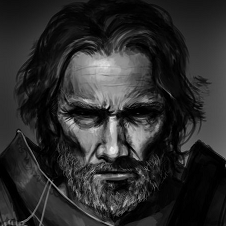-
Posts
37,683 -
Joined
-
Last visited
Content Type
Profiles
Forums
Events
Gallery
Everything posted by Ace-Garageguy
-
The longest wheelbase Mopar torsion-bar chassis I know of right off hand is the Monogram '70 Superbird. That car had a 116 inch wheelbase, but the Monogram model is 1/24, so if you use it in a 1/25 car, it scales out to about 120 inches. You'd still have to modify the chassis somewhat to get the correct 124 inch wheelbase for the 300. The monogram Superbird can be had for as little as 6 bucks on ebay. Possibly a more accurate donor would be the Lindberg '64 Dodge 330. It is 1/25, and the real car had a wheelbase of 119 inches. You would have to lengthen that chassis also to get it to the correct 124" for the 300. All the Mopars of that era used very similar chassis designs of different lengths, even the pony cars.
-
When you first said "two tone" I really didn't think I was going to like it. Especailly with the shaved handles and emblems, this car has such good lines and proportions it doesn't need much to look outstanding. BUT, what you came up with works great on this body style and really makes an attention-grabbing model. Interesting, unusual color choices, and I like the dark on the top. Nice ideas.
-
My associate bought a fairly complete east-coast '30 coupe, rusty but buildable, a little over a year ago for about 5 grand. Sold the chassis and mechanicals on and recovered about a couple thou. Just a decent body shell needing a lot of work for a '32 roadster at the same time was over 6 grand. 3 grand for an A coupe shell, 6 grand for a '32 roadster shell. I'm personally building a '30 roadster on repop '32 rails. '32s are beautiful cars and I love them, but I honestly couldn't possibly aford to do a nice steel '32.
-

Russian Awesomeness
Ace-Garageguy replied to Lownslow's topic in General Automotive Talk (Trucks and Cars)
How about the size of the door handle? Nah, it's just owned by a really big dude. -

How does Tamiya do it so quick?
Ace-Garageguy replied to Jon Cole's topic in General Automotive Talk (Trucks and Cars)
The Japanese have been pretty good at bringing out new products quickly for a long time. Look at the history of their 1:1 motorcycle industry for a convincing example. If I remember correctly, the Honda Formula One engine also went from a clean sheet of paper to a running unit very quickly. There was a time America could do some pretty spectacular pulling of rabbits from hats too. The P-51 fighter only took six months from napkin sketch to test flight. The Lockheed U2 and SR-71 Blackbird each took less time to design and get flying (all without CAD by the way) than some widely anticipated kits of '50s cars have been in gestation. So, why is it possible to build an all new motorcycle, or an exotic racing engine, or extremely high performance aircraft in less time than it takes to make a MODEL KIT of something that already exists and doesn't have to function ???? I think the changes in the American business model, which has become more about covering-your-backside than actually getting something done, and complicating the process with gibberish baloney like "brand cross-platform deliverables" and "redefine back-end initiatives" is largely responsible. -
Fine fine looking work.
-

Aluminum Willys Coupe: finished pictures posted 8/2/12
Ace-Garageguy replied to John Teresi's topic in WIP: Model Cars
Beautiful work. -
Yes, that's part of what I was getting at too. Right now you can get a desktop unit for less than $200 / month, but only a few years ago, they were $30,000 for a machine that would do the same thing. I can easily imagine the cost coming down to the level of a high-end personal computer. Depending on the cost of the files, the entire annual outlay for models could conceiveably be in line with what some of us are paying now for styrene and shipping.
-
There are without a doubt some copyright issues, and they will be determined by things like specific subject matter and whether it's become public domain. I would be interested to know if Modelhaus, for example, is forced to pay licensing on the representations of older Big 3 American cars they produce. No one can stop you from scratch-building a perfect model of a brand new whatever for your own enjoyment, so it follows that no one can stop you from creating digital files to run a 3D printer, for your own enjoyment. It's when you go to make multiple copies for sale that the licensing issues come up, as Brian said, BUT giving away free copies would probably violate copyright law. Technology is changing the entire landscape of intellectual property ownership and how it's interpreted everywhere. As far as the eye-hand skills go, I never meant to imply it doesn't take a lot of skill to build something well in a virtual environment, but it's an entirely DIFFERENT skillset than traditional modelers use. At one time I made a pretty good living doing prototyping for industry. I've been pretty well replaced by computer programmers and machines, and most of the people I've talked to in the new version of the industry admit cheerfully that they couldn't do what I used to do by hand, period. I can't do what they do, either. Yet.
-
Man, a hot-rod 7. too cool. Have you guys ever seen the Donkervoort cars? They're a development of the Lotus / Caterham 7, but on mega-steroids. http://www.donkervoort.nl/en/
-

'32 Ford roadster gluebomb rework. April 26: back on track
Ace-Garageguy replied to Ace-Garageguy's topic in WIP: Model Cars
Ummm......Gone? It wasn't uncommon at all to put hidden door hinges on these things. Not real common, but doable and a well known mod back in the dim recesses of time. The car's going to be gloss black lacquer, and I just didn't want to fiddle with sanding and polishing around hinges....so, they're "hidden". -
That's kinda what I was getting at about learning new skills.....like modifying illustrations and photographs into 3-view drawings, and then on to printable formats. It's a jell of a lot easier to manipulate an image in a computer (no sculptural ability and tool-using eye-hand coordination necessary) than it is to scratchbuild, eh?
-
Fiddling with the nose and tail. Thinking of doing a floating surround for the grille. The rear panel I'd started to use has moved to the front, and a similar panel, again sort of Pontiac looking, has grown on the rear so both ends will have some design unity. Also moving the windshield back a few scale inches. Mostly dechromed at this point, too.
-

'32 Ford roadster gluebomb rework. April 26: back on track
Ace-Garageguy replied to Ace-Garageguy's topic in WIP: Model Cars
Getting there........letting the primer shrink in while I work on other parts of the build. -
One thing I've been happy to see is a rekindling of interest in models in the 1:1 hot rod mags, and a good number of younger guys building traditional hot-rods in 1:1. Taking a young person for a ride in something fast and loud and somewhat scary can often open a door to experiencing life in the first person, as opposed to canned virtual "reality". The car model hobby has NEVER excited everyone, but it has the potential to last if WE get kids involved with making REAL things.
-

giving casting a motor a shot
Ace-Garageguy replied to Lownslow's topic in Car Aftermarket / Resin / 3D Printed
Art Anderson: "Amaco X-11 moist pottery clay works beautifully, and cleans up with water." Thank you sir. Great to know. -
Quoting old-hermit: "3-D tech is a boon for the hobby and resin casters already. You can create a file, have it printed, use it for a master, cast it and sell copies. The sales of the castings can offset any up front costs." Indeed, but with the price of 3D printing continuing to fall and the resolution increasing, it won't be long before "casting" in resin just isn't necessary. Models could be printed to order....again, no tooling cost is the attraction here. There is already a company making a D-Jag and an Aston Martin in 1/24 this way, and the costs are in line with what you'd pay for a traditional cast-resin kit. Some large-scale automotive and aircraft engines are also available, printed-to-order. It would eliminate inventory as well...all you need is a drum of goo. No unsold inventory either, when the marketing department screws up. If it just didn't get made, it doesn't have to be disposed of at a loss when it doesn't sell in the predicted numbers. Honestly, if I were Revell and had the kind of lead-times they're facing now, I'd be seriously investigating this tech in order to survive long-term. If you look at the increase in home computing power versus the cost over the past few years, and extrapolate the probable increase in 3D printing power versus cost over the next ten years, say, I think it's quite feasible to think of having a printer on one's hobby bench, and ordering up a print-to-order model on the spot, all for costs comparable to what we pay now for an injection-molded model plus shipping,
-
62 rebel, that's an excellent point. However, my understanding of copyright law MIGHT make it entirely possible for a modeler to copy an existing design "for his own enjoyment", rather like CDs and DVDs can be exhibited in a home environment, where there isn't any copying with intent to profit. I mean, you can scratchbuild anything, and the copyright police don't come knocking.
-
I posted some of this on another thread, but thinking it might get lost, I decided to open a new topic: Technology MAY bring a new "golden age" for modeling in the near futire. The cost of 3D printing is plummeting as the tech matures, and it's now possible to get a desktop 3D printer for $200 a month or less. At one time, a machine that had that capability was $30,000. Google sketchup is almost free-CAD, and has an extension to convert files created in it to a format that will run 3D printing apps. There is a guy in my local club who is actually making use of this technology and producing some parts that were previously only available if one was a very accomplished scratchbuilder. (Interestingly, he's one of the oldest modelers in the club, but is embracing the new tech like a kid.) What this means for any of us who choose to learn a few new skills is that ANY model can be produced with NO TOOLING WHATSOEVER. If you want a Borgward, go measure one carefully, or find blueprints, draw it up in sketchup, and have it 3D printed in wharever scale you want. Or do your own original design. There are companies that will "print" it from your files, for a reasonable fee. You can do this today, right now. The cost will continue to come down, and while not acessible to modelers of all income levels, a lot of current stuff isn't either. There are a lot of talented designers who are content to work on their creations and build them in a virtual world. BUT, I think there will always be an appeal to have real, 3-dimensional models that can be touched. The available tech allows the best of both approaches to merge into a super-modeling capability. So, who's up for moving the hobby into the 21st century?
